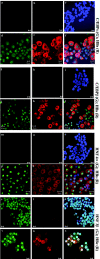Hepatocyte-like cells transdifferentiated from a pancreatic origin can support replication of hepatitis B virus
- PMID: 16189013
- PMCID: PMC1235835
- DOI: 10.1128/JVI.79.20.13116-13128.2005
Hepatocyte-like cells transdifferentiated from a pancreatic origin can support replication of hepatitis B virus
Abstract
Recently, a rat pancreatic cell line (AR42J-B13) was shown to transdifferentiate to hepatocyte-like cells upon induction with dexamethasone (Dex). The aim of this study is to determine whether transdifferentiated hepatocytes can indeed function like bona fide liver cells and support replication of hepatotropic hepatitis B virus (HBV). We stably transfected AR42J-B13 cells with HBV DNA and examined the expression of hepatocyte markers and viral activities in control and transdifferentiated cells. A full spectrum of HBV replicative intermediates, including covalently closed circular DNA (cccDNA) and Dane particles, were detected only after induction with Dex and oncostatin M. Strikingly, the small envelope protein and RNA of HBV were increased by 40- to 100-fold upon induction. When HBV RNAs were examined by primer extension analysis, novel core- and precore-specific transcripts were induced by Dex which initiated at nucleotide (nt) 1820 and nt 1789, respectively. Most surprisingly, another species of core-specific RNA, which initiates at nt 1825, is always present at almost equal intensity before and after Dex treatment, a result consistent with Northern blot analysis. The fact that HBV core protein is dramatically produced only after transdifferentiation suggests the possibility of both transcriptional and translational regulation of HBV core antigen in HBV-transfected AR42J-B13 cells. Upon withdrawal of Dex, HBV replication and gene expression decreased rapidly-less than 50% of the cccDNA remained detectable in 1.5 days. Our studies demonstrate that the transdifferentiated AR42J-B13 cells can function like bona fide hepatocytes. This system offers a new opportunity for basic research of virus-host interactions and pancreatic transdifferentiation.
Figures











Similar articles
-
[An in vitro model of hepatitis B virus gene replication and expression in primary rat hepatocytes transfected with circular viral DNA].Zhonghua Gan Zang Bing Za Zhi. 2002 Aug;10(4):275-8. Zhonghua Gan Zang Bing Za Zhi. 2002. PMID: 12223138 Chinese.
-
[Study on the replication of Hepatitis B Virus in primary hepatocytes from heterogenous species].Zhonghua Gan Zang Bing Za Zhi. 2004 Jan;12(1):25-8. Zhonghua Gan Zang Bing Za Zhi. 2004. PMID: 14761278 Chinese.
-
Pregenomic RNA Launch Hepatitis B Virus Replication System Facilitates the Mechanistic Study of Antiviral Agents and Drug-Resistant Variants on Covalently Closed Circular DNA Synthesis.J Virol. 2022 Dec 21;96(24):e0115022. doi: 10.1128/jvi.01150-22. Epub 2022 Nov 30. J Virol. 2022. PMID: 36448800 Free PMC article.
-
The Role of cccDNA in HBV Maintenance.Viruses. 2017 Jun 21;9(6):156. doi: 10.3390/v9060156. Viruses. 2017. PMID: 28635668 Free PMC article. Review.
-
Hepatitis B virus cccDNA: Formation, regulation and therapeutic potential.Antiviral Res. 2020 Aug;180:104824. doi: 10.1016/j.antiviral.2020.104824. Epub 2020 May 22. Antiviral Res. 2020. PMID: 32450266 Free PMC article. Review.
Cited by
-
MicroRNA-22 can reduce parathymosin expression in transdifferentiated hepatocytes.PLoS One. 2012;7(4):e34116. doi: 10.1371/journal.pone.0034116. Epub 2012 Apr 6. PLoS One. 2012. PMID: 22493679 Free PMC article.
-
Stem Cell-Based Therapies for Liver Diseases: An Overview and Update.Tissue Eng Regen Med. 2019 Feb 21;16(2):107-118. doi: 10.1007/s13770-019-00178-y. eCollection 2019 Apr. Tissue Eng Regen Med. 2019. PMID: 30989038 Free PMC article. Review.
-
Transdifferentiation of human fibroblasts into hepatocyte-like cells by defined transcriptional factors.Hepatol Int. 2013 Jul;7(3):937-44. doi: 10.1007/s12072-013-9432-5. Epub 2013 Mar 13. Hepatol Int. 2013. PMID: 26201932
-
Risk Factors for Pancreatic Cancer: Emerging Role of Viral Hepatitis.J Pers Med. 2022 Jan 10;12(1):83. doi: 10.3390/jpm12010083. J Pers Med. 2022. PMID: 35055398 Free PMC article. Review.
-
Regulation of hepatitis B virus replication by the phosphatidylinositol 3-kinase-akt signal transduction pathway.J Virol. 2007 Sep;81(18):10072-80. doi: 10.1128/JVI.00541-07. Epub 2007 Jul 3. J Virol. 2007. PMID: 17609269 Free PMC article.
References
-
- Babinet, C., H. Farza, D. Morello, M. Hadchouel, and C. Pourcel. 1985. Specific expression of hepatitis B surface antigen (HBsAg) in transgenic mice. Science 230:1160-1163. - PubMed
Publication types
MeSH terms
Substances
Grants and funding
LinkOut - more resources
Full Text Sources
Research Materials

